Greensboro Montessori School hosted two teacher workdays this fall, each dedicated on professional development. Classrooms were closed giving our team uninterrupted time to focus on learning new skills and growing as educational professionals. So how did the team use their time?
During our September 20 workday, faculty paused to reflect on the work we do with students every day and our approach to guiding them in their meaningful work. Nancy VanWinkle, instructional coach, and Jessica White Winger, director of student support, led a workshop designed to build teachers’ tool sets for preparing the environment, particularly expanding the resources of the prepared teacher. The theme was building a “Community of Reflective Practitioners,” with a focus on leveraging the collective experience of the educators in the room.
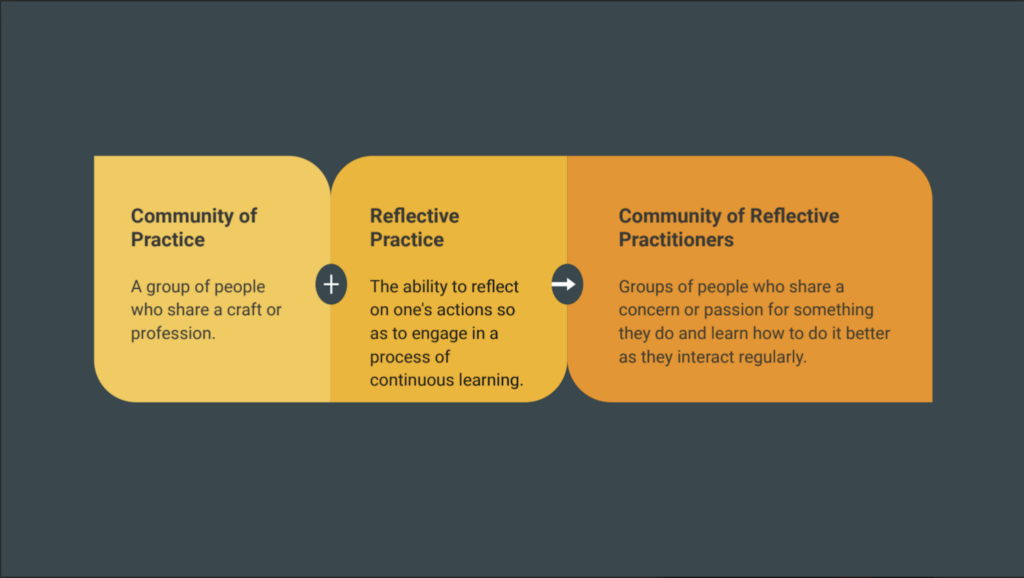
Teachers worked in mixed-division groups, with varying years of experience in the field. The morning opened with a grounding activity in which teachers were shown photographs of individuals who have affected positive change in the world. These individuals have raised awareness around difficult issues, often putting their lives and work at risk to do the “right” thing. Teachers were asked to work with their groups to list the qualities of one of those changemakers. Following a share-out, the group reflected on how we can encourage these qualities in all of our students. This impactful exercise grounded us in the knowledge that each child is under “self construction” and we have the big responsibility of allowing their true light to shine, while helping guide them in becoming their best self.
Following this exercise, Nancy and Jessica shared what resources and experiences they have to support teachers during the 2023-24 school year. As our instructional coach, a role dedicated to support faculty in their professional development, Nancy worked closely with Jessica to design a collaborative problem-solving approach for schoolwide implementation. The model offers teachers a practical tool for seeking input from one another and leveraging the cumulative knowledge of our faculty and staff.
This collaborative problem-solving model has teachers sharing a specific behavior they are experiencing with a child in their classroom. A group of educators, with one facilitator and one recorder, reflects on the overall question, “What’s going on with this child?” and what are the unmet needs, lagging skills, or obstacles that the student might be encountering? By looking at the heart of the issue, we honor the child and seek to better understand what their behavior is telling us. The facilitator then takes the group through a series of brainstorming questions, while the recorder writes strategies and suggestions. In the end, the teacher chooses a strategy to try out for a week and agrees to report back to the group. At that point, they may revisit the brainstorm and select another strategy to try.
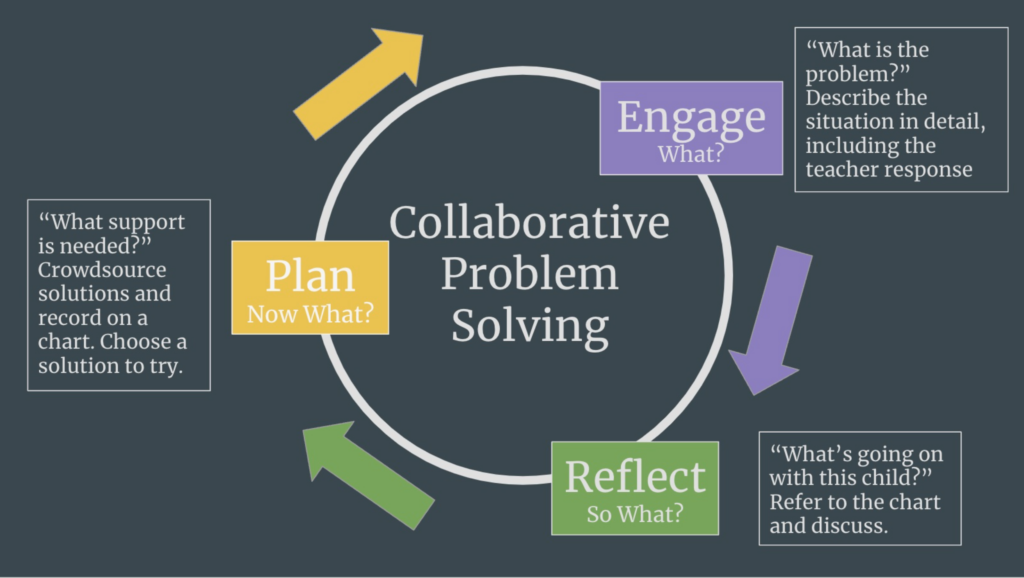
After modeling this process for everyone, teachers split into their mixed-division groups to practice the model. The value of this collaborative approach is vast, as it’s an opportunity for teachers to gain new perspectives and insight, helping create a shift in paradigm and introducing new ways of responding to student needs. It’s about connecting with colleagues and taking a child-centered approach, as much as it’s about reflecting on our own vulnerabilities and finding strength in the process. It is not about “fixing” a behavior, but opening ourselves to trying new approaches and embracing the spirit of the child.
During our October 6 teacher workday, our group of reflective practitioners reunited to share how our new system of collaborative problem solving is helping them in the classroom. Mixed-division groups reported out on strategy successes and areas of growth. More teachers had the opportunity to share a new challenge with their groups and seek strategies to try. Faculty feedback for this process has been overwhelmingly positive, and we are excited to be working closely together to authentically support students and to address their most critical needs.
Teachers spent the latter half of the workday looking at the scope and sequence of their Montessori curriculum, evaluating it with a fine-toothed comb to ensure fidelity and best-practice in every classroom. This “big work” is just one more way we are reflecting on our practice and ensuring that every student at GMS is engaged in meaningful work as they progress from Toddler through Junior High.
Through intentional planning, we make professional development at GMS relevant and meaningful. We consistently follow-up with faculty to ensure we are meeting their needs and supporting their professional growth. From workshops, trainings, and conferences to observations at other schools, professional development offers inspiration and connection for GMS teachers.
Dr. Maria Montessori was nominated for the Nobel Peace Prize in 1949, 1950, and again in 1951. Dr. Martin Luther King, Jr. was awarded the Nobel Peace Prize in 1964, becoming the youngest man to receive the honor at the time. They were both influenced in their work for peace by Mahatma Gandhi. In the 1930’s Maria Montessori met Mahatma Gandhi while she was living in India, and Gandhi gave a speech to Montessori teachers in training in London in 1931. There he said of her work, “You have very truly remarked that if we are to reach real peace in this world and if we are to carry on a real war against war, we shall have to begin with children.” While Dr. King did not meet Gandhi in person, he referred to him as “the guiding light of our technique of nonviolent social change.”
These three peacemakers have been great influencers across cultures. Dr. Montessori established educational training programs that have led to thousands of schools all around the world. Dr. Martin Luther King, Jr. organized peaceful protests that changed civil rights laws in the United States and inspired future peaceful protest around the world. They all changed the world through peaceful efforts.
At Greensboro Montessori School, we implement the peace curriculum at every age level - from guiding toddlers to self calm to teaching peaceful conflict resolution in our preschool and elementary classrooms, to visiting the United Nations in Junior High. We seek to provide experiences for children to understand and access the peace within themselves, to relate with other people, cultures, and the environment, and to embrace the complexity of humankind. When children are given opportunities to practice peace within themselves, they will be able to share it with others and seek it out in the world.
Dr. Martin Luther King, Jr. said, “The function of education is to teach one to think intensively and to think critically.” These peacemakers have influenced generations. And inspired by their work, Greensboro Montessori School is educating the next generation of peacemakers and innovators.
Greensboro Montessori School's Upper School students took a leading role in Friday's Earth Day celebration. Upper Elementary students kicked off the morning with readings of original poetry and Spanish. After the program (which we shared live on Facebook), Junior High students hosted Lower and Upper Elementary students at eight different different stations set up on the Athletic Field. Each station featured an activity to to raise awareness for Earth Day, including ideas for recycling, composting, and even limiting our waste. Primary students enjoyed a lesson with our environmental educators, Chelsi Crawford and Sara Stratton. Toddler students took everything in from their shaded mats under the trees, just steps away from their play yards.
The original poetry shared by our Upper Elementary students highlights our integrated curriculum. Students combine their skills in English, Spanish, creative writing, science, environmental education, public speaking, and leadership all at once. We are honored to publish their work for all to experience.
Redbud Tree
Lydia, Sixth Grade
The Eastern redbud tree, purple blossoms in early spring. Small beacons of colour adorn the dull, monochromatic landscape. Bursts that spring is just around the corner.
As the blossoms begin to fade, they get swept away by the gusts of wind that spring brings. Petite purple petals pressed onto the ground as they get trampled by tiny feet. But not all is lost, leaves that are a deep crimson, like garnet, or a sharp, zesty lime the size of a hand unfurl. The leaves are shaped like spades. Desperately trying to hold onto their branches by their paper-thin stems. Through treacherous storms they hold on, not falling yet, for the leaves have roots of their own.
The redbud tree is eternally stretching, reaching its roots through the mycelium and soil, while the branches are competing for the warm rays of sunlight. The uneasy cottontail rests by the roots of the tree, protected by the lush canopy from the hungry hawks’ view.
During autumn, the leaves of the redbud tree glow orange, like a campfire. Only turning into a bonfire as the chorus of the other deciduous trees chime in in the early November. Then, the redbud tree goes to sleep as the long, cold winter days begin.
Día de la Tierra Upper Elementary Group A
- Debemos cuidar la Tierra porque es el único planeta que temenos.
- Debemos cuidar la Tierra porque es nuestra casa y nuestro hogar.
- Debemos cuidar la Tierra porque vivimos en ella.
- Debemos cuidar la Tierra porque hay animales, árboles, océanos y más.
- Debemos cuidar la Tierra porque es la casa para todos los tipos de vidas.
- Debemos cuidar la Tierra porque nos da comida.
- Debemos cuidar la Tierra porque es la casa de todos.
- Debemos cuidar la Tierra porque es muy bonita. Los humanos debemos comprender que no se debe hacer daño a la Tierra.
- Debemos cuidar la Tierra porque o si no nos extinguieremos.
- Debemos cuidar la tierra porque es nuestra protectora y nuestro hogar.
sphagnum
Tanner, Fourth Grade
The sphagnums dance in the rain like an umbrella being twirled. The sphagnums dance in the rain on the mother tree. The sphagnums dance in the rain in the rainforest. The sphagnums dance in the rain under the shade. The sphagnums dance in the rain and the damp mother tree is playing her music. The sphagnums dance in the rain, their spore capsules open up and the spores fly away. The sphagnums dance in the rain as the 10,000 ancestors watch them. The sphagnum dances in the rain, the calm green color is shimmering on as the rain falls on them, the sphagnums dance in the rain; they have no roots, stems, leaves or seeds. The sphagnums dance in the rain, they can grow until they run out of room. The sphagnums dance in the rain in their fuzzy soft coats. The sphagnums dance in the rain. They are used for medicine to save peoples lives. The sphagnums dance in the rain; they get picked and re-planted to make a garden look nicer. The sphagnums dance in the rain.
Greensboro Montessori School partners with the Northwest Evaluation Association (NWEA) to use Measure of Academic Progress (MAP) Growth assessments. MAP Growth is a computer-adaptive test for measuring individual student achievement and growth in math, reading, and language usage.
We've chosen MAP Growth because it is a student-centric approach to standardized testing. Unlike paper and pencil tests, where all students are asked the same questions and spend a fixed amount of time taking the test, MAP Growth is an adaptive test. That means every student gets a unique set of test questions based on responses to previous questions. At the end of each test, teachers are able to determine what individual students know and are ready to learn next.
Unlike traditional standardized tests, MAP Growth testing is administered twice a year, enabling us to measure our students' individual growth over time. Teachers may also use test results to further inform instruction, personalize learning, and monitor student growth.
While we are not a test-driven school, we know test taking is a practical life skill students need in preparation for high school and college. MAP Growth tests are one form of assessment we use, in conjunction with other methodologies of formative and summative assessment given throughout the school year.
About MAP Growth
No. As a computer-adaptive assessment, MAP Growth will provide questions to test the upper limits of your child's skills. Every student will miss questions. The MAP Growth guides suggest that students should expect to miss 40-60% of their questions.
There is no particular score for which students should aim. Instead, your child's individual MAP Growth Report will contain a RIT score. This score represents their achievement level at the time they took the test. As a partner in your child's education, we are less concerned one-time scores and will focus more attention on students' growth measures between assessments.
During MAP Growth
After MAP Growth
Preparing for MAP Growth Assessments
There is nothing families need "to do" in preparation for a MAP Growth test. We encourage families to follow the child – provide the level of support they need to feel successful. This could vary between treating an assessment day like any normal school day to practicing questions on a sample to get comfortable with the format, to talking with your child about the practical life skill of testing (i.e., tests are part of education and you should do your best, and you should not worry or stress over tests).
If you'd like to provide a strong framework for your child before and during a test, we have these tips:
The Night Before
- Relax and have fun.
- Enjoy a healthy snack an hour before bedtime.
- Get a good night's sleep.
The Morning of the Test
- Fill up on healthy, complex carbs and protein.
- Slow-release carbohydrates, like whole rolled porridge oats, whole grain bread, low-sugar muesli, and fresh fruit with a low glycemic index, help provide consistent energy levels throughout the morning.
- Proteins, such as milk, yogurt, or eggs, keep students feeling full and can lead to greater mental alertness.
- Prepare and bring a healthy midmorning snack to school.
- Arrive at school on time – no later than 8:15 a.m.
- Connect with a friend or teacher if you have pretest jitters.
During the Test
- Take three deep breaths.
- If you don't know the answer, give your best guess and move on.
After a long day away from our children, we parents are eager to hear all the details about how they have spent their time. However, so often our queries of “What did you do today?” are met with the same predictable response: “Nothing.” For children, distilling the many details and experiences of a full day at school into an anecdote or two is a tall order. What tools can we use to get them talking about their learning?
Vidigami
Through the Vidigami private photo sharing platform, you get to see moments of your child’s day at school. Viewing photos of your child engaged with Montessori materials can inspire great conversations. Children, especially those younger than five, are not yet able to summarize and describe the many things they experience over the course of a full and stimulating school day. However, photos offer visual cues that trigger a child’s memories and invite them to comment on specific materials and activities. There are many different ways to talk about these photos with your child, and we've provided some suggestions, which focus on your child's intrinsic motivation. Enjoy these special conversations as you allow them to teach you what they are learning at school.
- Ask your child to tell you about the photo. You may learn what they see in the classroom, or what they remember about the moment, and it may be much more than meets the eye.
- Say what you see without judgement. “I notice you are in the classroom.” “Do you know the name of that work?” “There are a lot of colors in your drawing.”
- Speak about their efforts instead of praising their product. “You really look like you are concentrating.” “Is that the first time you have done that work?” “I see your smile. What did you like about that work?” “Are you building with those blocks?”
Intrinsic Motivation
Listening to your child talk about the photos and speaking without judgement encourages your child's intrinsic motivation – it allows them to continue to work for their own sake, rather than for any praise from adults. As Montessori teachers, we get to witness this intrinsic motivation every day. It looks different at each age grouping and is a critical element to Montessori education. Many elements of the method foster intrinsic motivation without reward and judgement, such as control of error in the materials, allowing for repetition, assessment through observation, and relying on peers as sources of feedback and inspiration. Teachers try never to interrupt a concentrating child or judge their work. Instead, they seek opportunities for meaningful conversations before or after a student's work cycle.
As Montessori observed children, she saw time and time again the intrinsic motivation in the child to work through repetition for long, uninterrupted periods of time. In a book that examines Montessori’s relevance to today’s educational practices, "The Science Behind the Genius," Angeline Lillard refers to several current research studies confirming that rewards and punishments not only negatively impact intrinsic motivation, but also how a student performs on the task. Traditional reward methods used in most schools may actually hinder a child’s performance. Given the opportunity, children are capable of learning to take personal responsibility for their actions.
“Like others I had believed that it was necessary to encourage a child by means of some exterior reward that would flatter his baser sentiments … in order to foster in him a spirit of work and of peace. And I was astonished when I learned that a child who is permitted to educate himself really gives up these lower instincts.” – Dr. Maria Montessori
As a Montessori school, we believe deeply in educating the whole child: their academic, psychological, critical-thinking, moral, and social-emotional selves. In addition to the academic lessons and works your children are engaged in daily, our teachers and staff are also guiding your child through other very important lessons to help them with their moral and social-emotional development. For example, teachers give explicit lessons related to grace and courtesy, facilitate discussions at the peace table, and encourage collaborative work and play daily.
And, it turns out, research from our School confirms that we are doing this pretty well …
The Gratitude Project
We recently worked with Professor Jonathan Tudge and his team from the University of North Carolina at Greensboro ("UNCG") to study the development of gratitude as a virtue. As a virtue, gratitude goes beyond a positive feeling when something good happens. Virtuous gratitude is a disposition to act gratefully when someone else does something nice for you. Dr. Tudge explained it to me this way: “Saying 'thank you' is polite, but hardly a virtue. What makes gratitude a virtue is when beneficiaries of good deeds or significant help want to do something back for their benefactor if they have the chance to do so. That first act of generosity, followed by grateful reciprocity, leads to building or strengthening connections among people.”
In previous cross-cultural research, Dr. Tudge and his team found that most children develop this type of gratitude between the ages of 9 and 13, although the age differed depending on the cultural context. In their study, children in the United States developed virtuous gratitude at later ages than other cultures. Keeping this in mind, Dr. Tudge decided to target a new intervention designed to encourage the development of gratitude within adolescents.
Dr. Tudge and his team came to our School to explore this intervention. After working with our Upper School students, they stumbled upon a ‘good’ problem with their research: far more Greensboro Montessori School students exhibited virtuous gratitude than they expected. Our Upper Elementary and Junior High students expressed gratitude at much higher rates (67%) than did children in non-Montessori settings in the United States (46%). In addition, our students were almost twice as likely to express autonomous moral obligation (79%) than were children in non-Montessori schools (44%). Defined originally by Jean Piaget, autonomous moral obligation is a decision-making framework whereby moral decisions are made based on intrinsic motivations to do the right thing.
Dr. Tudge and his team were puzzled by these anomalous findings. Why did our students score higher than other American children, even when compared to other well-regarded private schools in the Greensboro area? And how are these findings related to Montessori pedagogy and culture?
Gratitude in the Montessori Classroom
In our discussions with Dr. Tudge, we discussed the way Montessori teachers prepare the environment to communicate honor, respect, and gratitude to the child. We also described the ways in which our teachers model gratitude and respect when they speak and interact with their students. In time, this becomes our students' definition of "how it's supposed to be.” In addition, we delineated how our grace and courtesy curriculum creates both a framework for community interactions and a schoolwide culture of character.
In collaboration with Dr. Tudge and his team, I presented the results from our Upper School students’ involvement with Dr. Tudge's gratitude study at the Association for Moral Education’s annual conference in Seattle, Washington.
In the presentation, we hypothesized that our students' high rates of gratitude could be due to several specific tenets of Montessori philosophy:
- Specific lessons about grace and courtesy provide explicit guidance on character development from a young age.
- Daily practice of grace and courtesy increase opportunities for proximal processes related to virtue development.
- Mixed age groupings of children may expose younger children to older children are further along in virtue development.
- Peer interactions encouraged from toddlerhood may increase opportunities for the development of mutual respect.
Dr. Tudge and his team also did some work with our Lower Elementary students. Tudge’s team again noted that so many of even these younger children (aged 6 to 9) expressed virtuous gratitude. Dr. Tudge reflected: “We think that this must say something about the character-based focus of the general Montessori curriculum, because a far greater proportion of Greensboro Montessori School children expressed gratitude than elsewhere.”
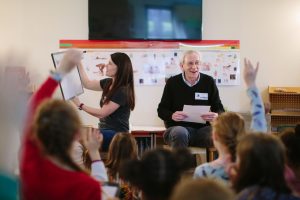
Dr. Jonathan Tudge and his team from UNCG discuss gratitude with Lower Elementary students from Greensboro Montessori School Students.
Character Education at Greensboro Montessori School
Overall, the results suggest that a Montessori environment is conducive to developing virtuous gratitude and autonomous moral obligation. These results – while surprising and interesting to the UNCG team and other researchers and educators at the Association for Moral Education conference – are not really that surprising to us. Focusing on strong character education is a key tenet of Greensboro Montessori School. A deep respect towards classmates and other people is so integral to our culture that it's not that surprising our Elementary and Junior High students authentically take their sense of gratitude to a level beyond just saying “thank you.”
“Turn it, and turn it, and turn it, and turn it, and turn it, and turn it, Compost Cake!”
“Pile it high, pile it high, pile it high, Compost Cake!”
If you’ve heard this song about compost all around campus this fall and winter, it’s because we got new compost bins in the Primary and Lower Elementary gardens! Why did we get new bins, you might ask? Two reasons:
- We needed more space for the volume of organic waste we produce (a combination of garden waste and food scraps from the students' lunches and snack preparation)
- We wanted to try a more interactive, faster, and developmentally appropriate compost model for our younger students.
So what did we get? If you visit the Primary and Lower Elementary gardens, you’ll see some giant green cylinders sitting on a rotating axis. These compost bins are called tumblers. Tumbler compost models allow students of all ages to spin the compost (working those gross motor skills), in addition to speeding up the composting process. In our old bins, it took at least a year for our food waste and garden scraps to decompose fully, we'll make finished compost in as little as two weeks. Cheers to that!
What is Compost?
Compost is the product that’s left after organic matter has fully decomposed. It’s also called humus. Human-made compost comes from carefully mixing food and garden waste materials — ingredients high in either nitrogen or carbon — and placing them in an environment where they can decay. When the decaying process has gone well, we put the finished compost, or humus, back into the garden soil and grow healthier plants by improving soil fertility.
Why do we compost at Greensboro Montessori School?
For starters, compost has a longer ground-life than other fertilizers. It lasts longer in soil than crop residues or animal manures that degrade rapidly here in the humid Southeast. This longevity makes for healthier plants and food crops. Composting also reduces our waste throughout campus. By diverting organic matter from the landfill and into a closed-loop cycle, we transform our “waste” into a fertilizer for our gardens and food for the microorganisms that live in the soil beneath us. We also save money by eliminating the need and associated cost of additional soil fertility inputs. And let's not forget, composting is just plain fun!
Can you think of any other reasons to compost? Maybe, that by doing it, we are feeding the worms our Toddlers so adore? That it’s a responsible use of resources? That it's a project-based way to teach science? Share your thoughts with us! And, if you want to learn more, please join us at our next Community Garden Workday for more composting tips and tricks with our environmental education faculty. We’d love to have you.
If you're interested in learning more about the science of composting, read this article from Live Science.
 About the Author
About the Author
Eliza Hudson is Greensboro Montessori School's lead environmental educator. Eliza holds her bachelor's degree in biology from Earlham College in Richmond, Ind. She has built and tended school gardens, taught hands-on cooking lessons and connected local farms to school programs working for FoodCorps. Prior to joining Greensboro Montessori School in 2014, Eliza was a classroom and after-school assistant at the Richmond Friends School, a farm intern at a family-owned farm in Ohio, and served as assistant director at a summer day camp in an urban community garden in Durham.
Greensboro Montessori School has taught environmental education since 1995 and has been permaculture gardening on its campus since 1997.
Within the three-year cycle of Lower Elementary (first through third grades), students and teachers spend one year studying the fundamental needs of humans. This theme is woven throughout their curriculum and students embark on relevant research projects providing purpose and context for their learning. Over the year, the students learn why food, water, shelter, clothing, art, and community are necessary for humanity and how these needs have remained consistent throughout our time on Earth.
One of the ways our students share their growing knowledge of human civilization, and our most basic needs, is through their Festival of Light presentation. Students read the book “Celebrations Of Light : A Year of Holidays Around the World” by Nancy Luenn. The book is a springboard to research projects centered on 12 countries and the light-themed cultural celebrations that both define and unite them. It provides exposure to the diversity of our world while simultaneously highlighting how light brings people together.
Students form teams, each taking one of the 12 countries and its respective celebration. From there, they delve into the history of the country, its culture, and the celebration. They study some of their nation’s accomplishments, art, food, geography, religion, storytelling, traditions, and writings. All of this research prepares them to participate in Greensboro Montessori School’s triennial Festival of Light.
The Festival of Light features all of our Lower Elementary students in an evening presentation for their families, faculty, and members of the greater school community. Each of the 12 teams prepares a narrative on their country’s celebration of light. The celebrations include:
- New Year's Eve in Brazil
- The Chinese New Year
- The Lantern Parade (Eid al-Fitr) in Sierra Leone
- Lichtmesdag in Luxembourg
- Buddha's birthday in Korea
- Bon Matsuri in Japan
- Diwali in India
- Loy Krathong in Thailand
- Hanukkah in Israel
- Luciadagen in Sweden
- Christmas in the United States
- Las Posadas in Mexico
- Kwanzaa in the United States
The presentation itself anchors our students’ research in purpose and provides these first, second, and third graders with a nurturing and challenging academic experience. Surrounded by their families, friends, and teachers, students share their knowledge in a safe space where they will be celebrated for their work. The Festival of Light also challenges our students by pushing them to develop and expand their public speaking and presentation skills in new ways.
When the last celebration has been presented, the audience chairs have been put away, and the families have left for home, there’s no doubt our students have been part of an educational experience. One that has taught them about the fundamental needs of humans, community, teamwork, and so much more.
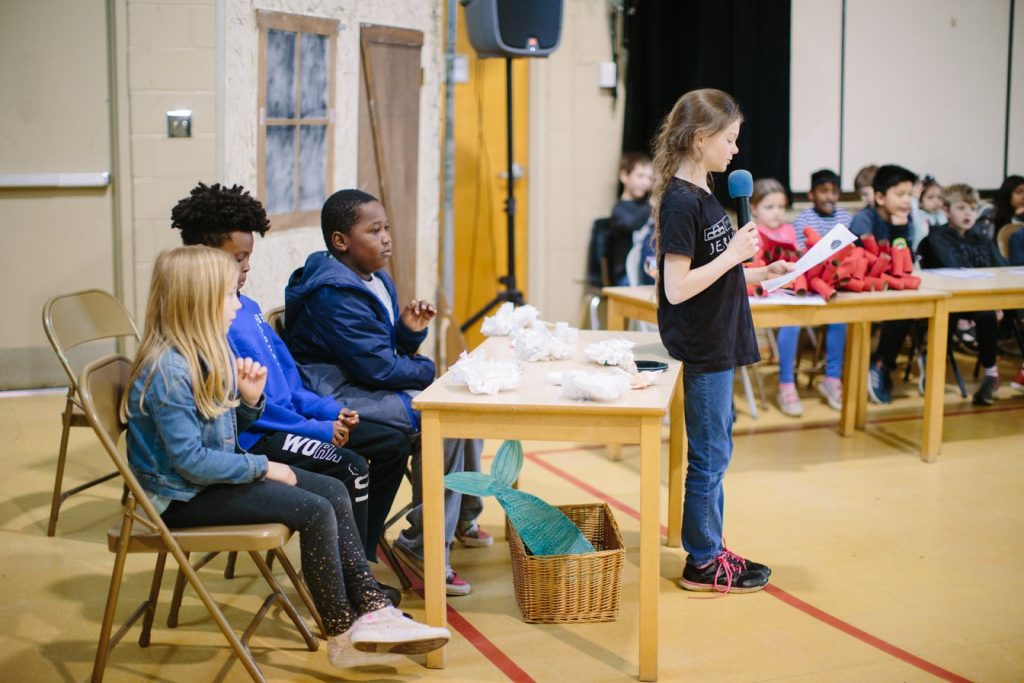
Lower Elementary students rehearse for Greensboro Montessori School's triennial Festival of Light.
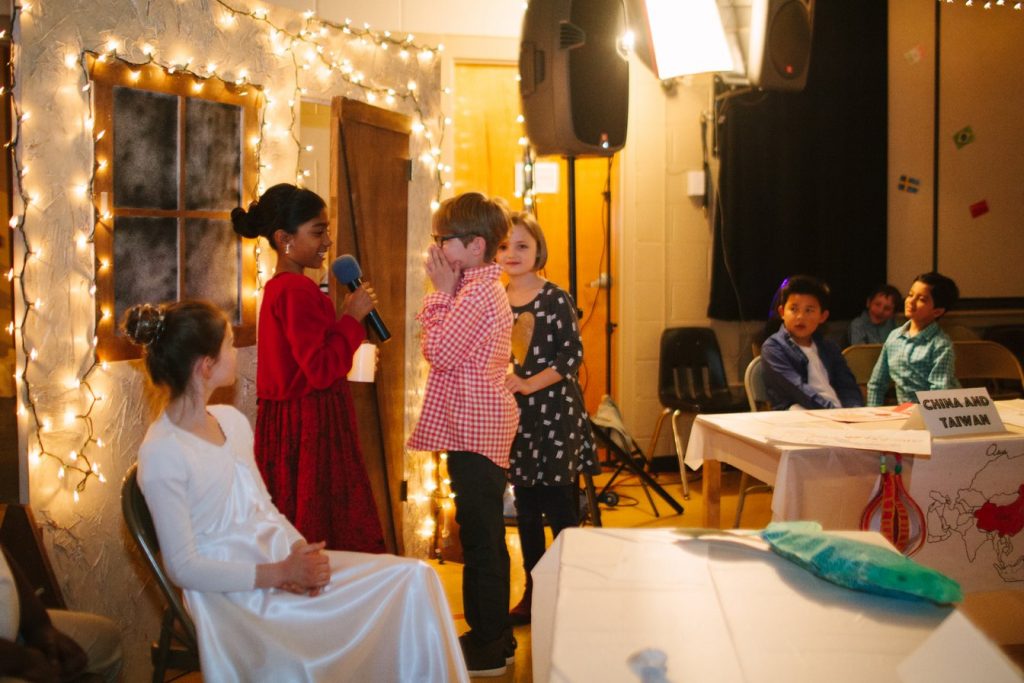
Students reenact the Candlemas tradition of going door to door singing for a candy treat.
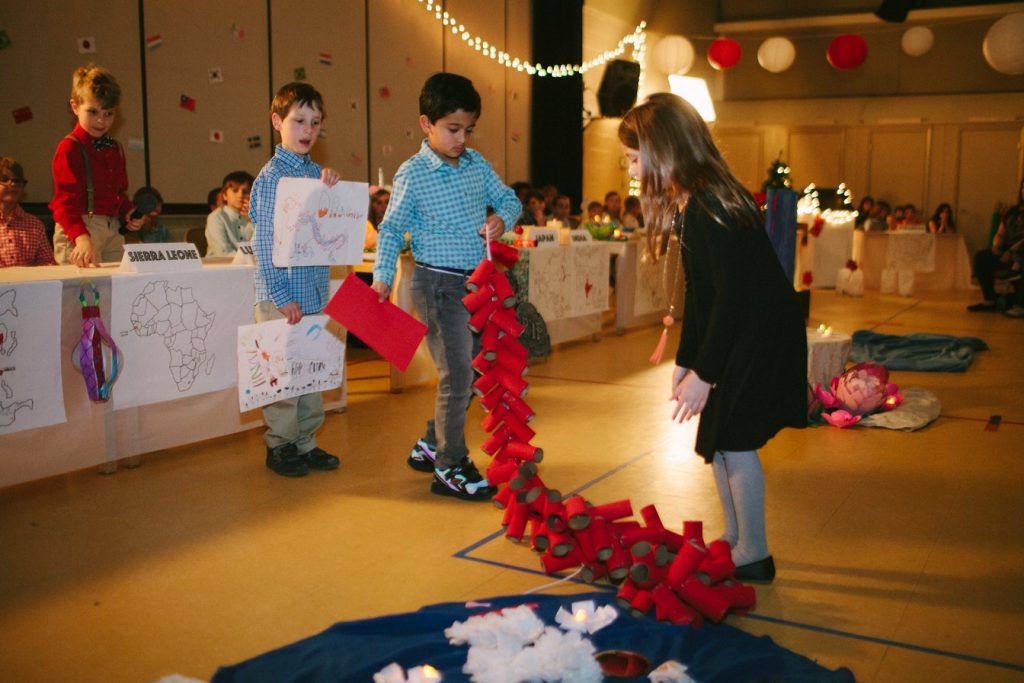
Students present the Chinese New Year, which is celebrated in China and Taiwan.
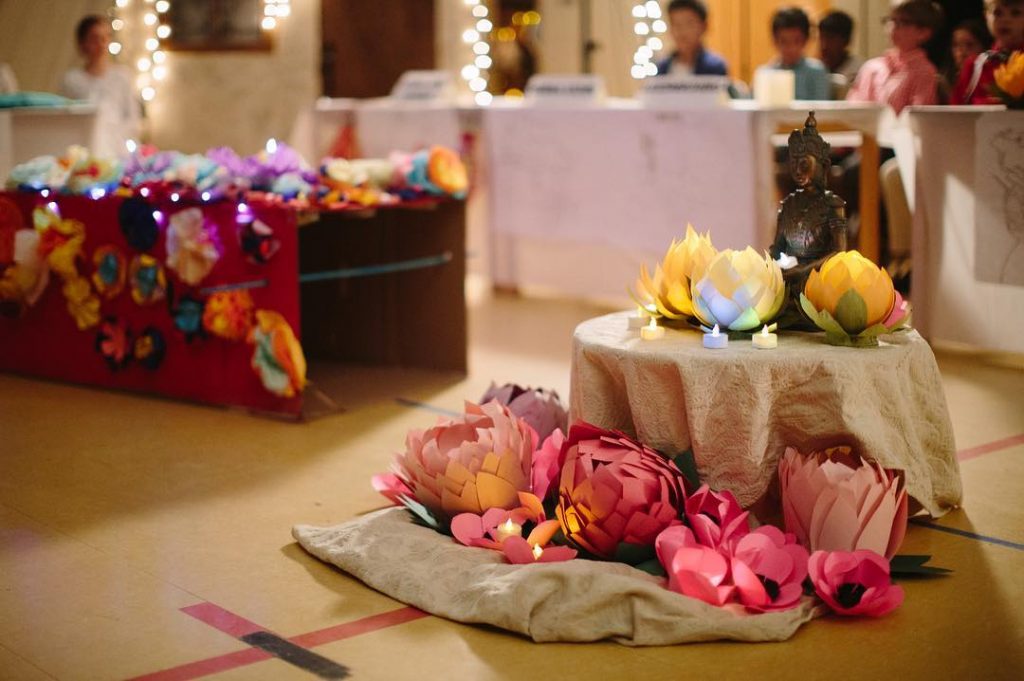
Pictured to the left is a student-made float for the Lantern Parade celebrating Eid al-Fitr in Sierra Leone. The celebration of Buddha's birthday in Korea is pictured to the right.
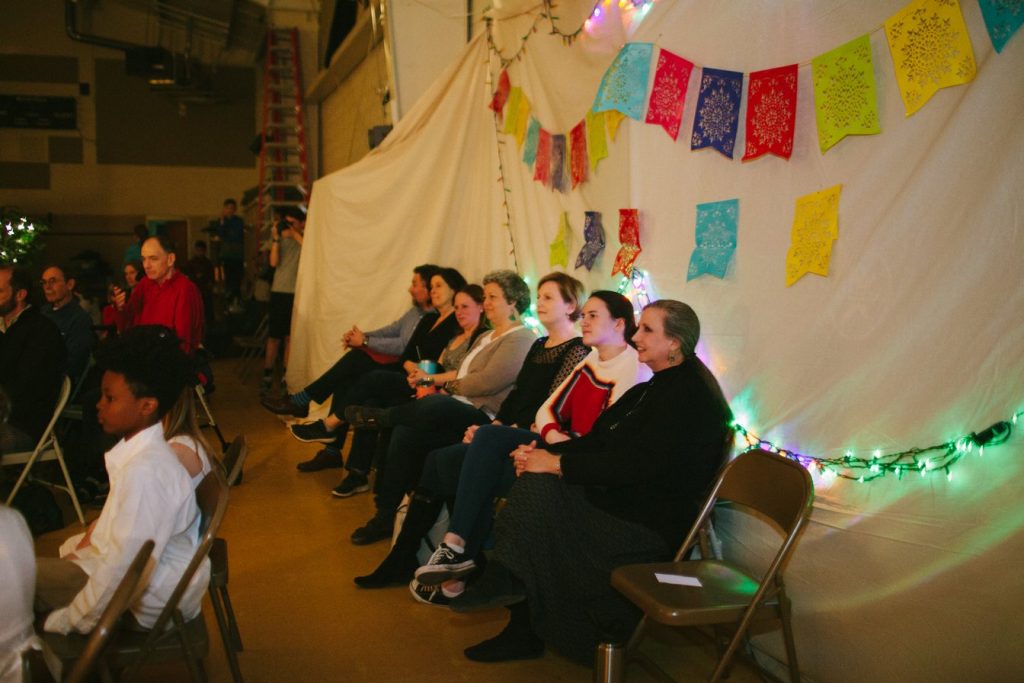
Here are the faculty, off to the side, letting the students take the lead in presenting their student research.

Students present the menorah and the lighting of the candles for Hanukkah in Israel.
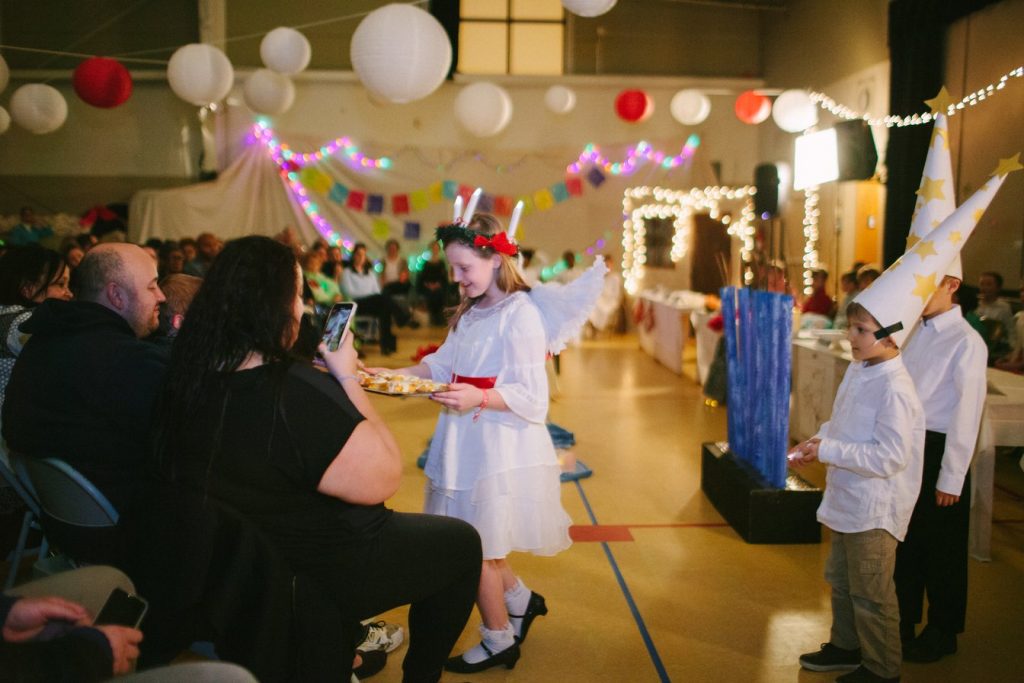
Luciadagen, or Lucia's Day, in Sweden, involves children dressing in all white and leading a procession while also handing out saffron buns.
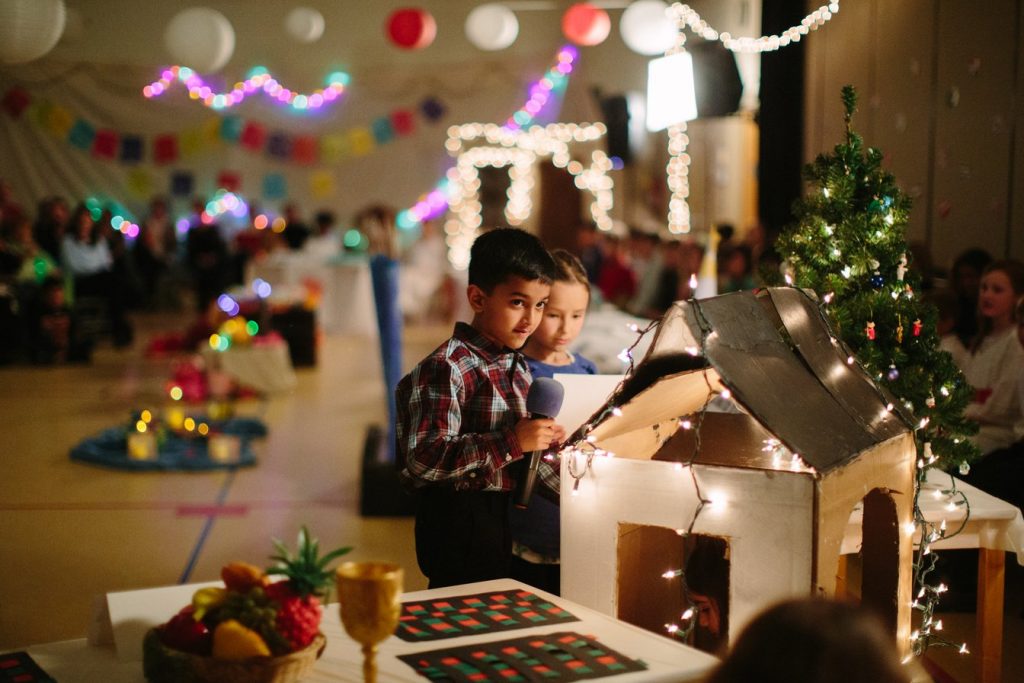
Las Posadas is a Christmas tradition from Mexico and is a reenactment of Mary and Joseph's search for the inn ("la posada") on Christmas Eve.

A third-grade student leads her peers in the final presentation of the night, a secular version of the song "This Little Light of Mine."
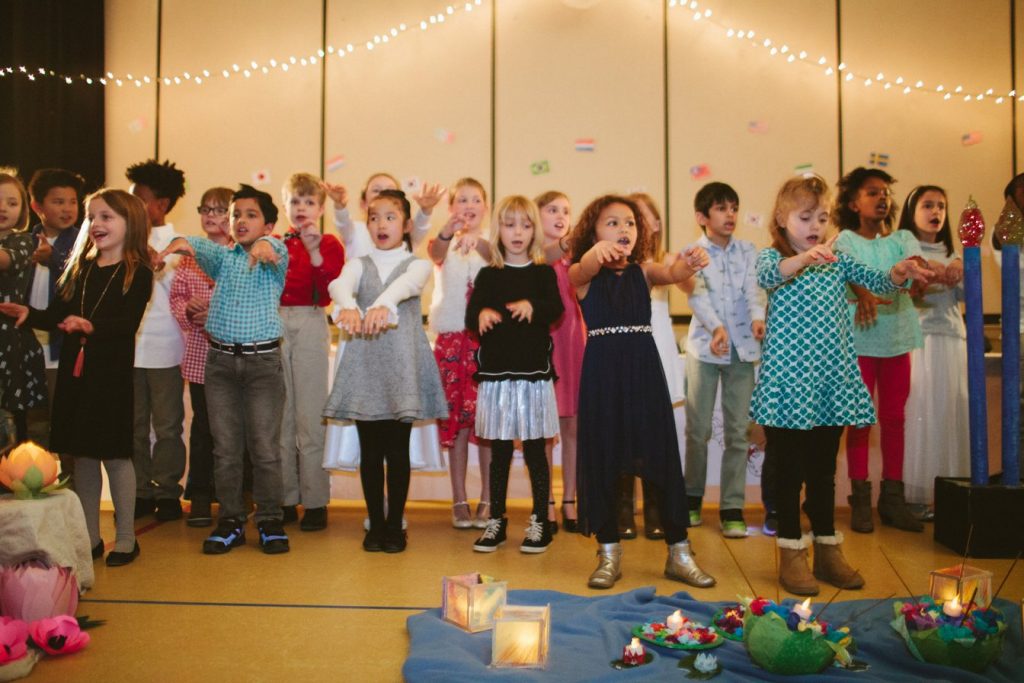
Students close their presentation by singing a secular version of "This Little Light of Mine."
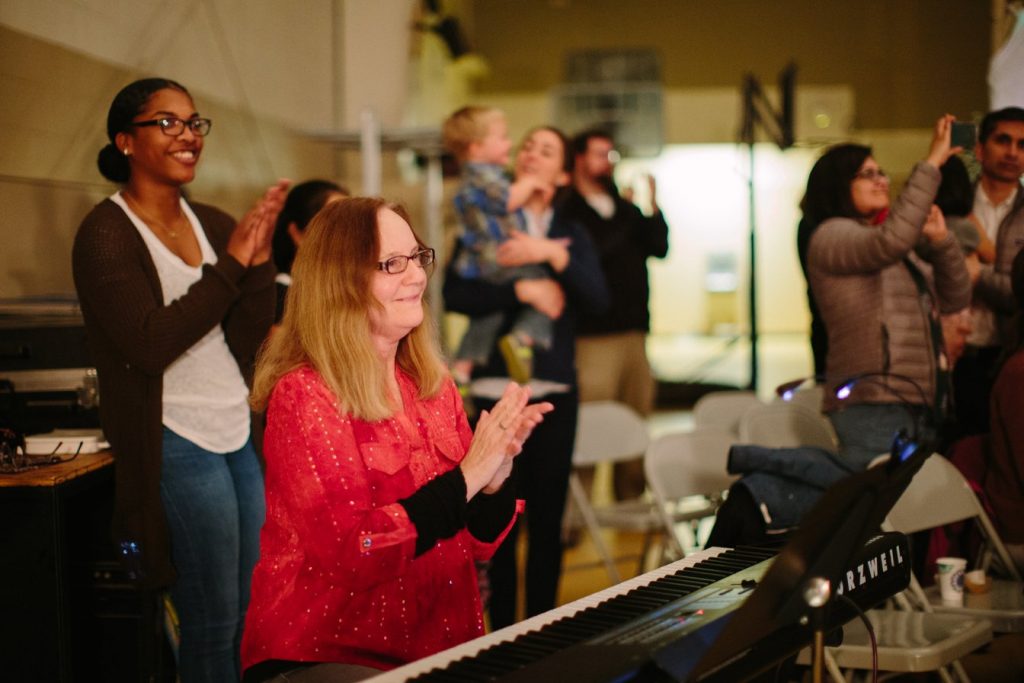
The Festival of Light comes to an end, and the students enjoy tremendous applause from the audience.
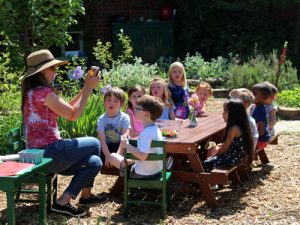
Sara Stratton leads Primary students in making dressing for their strawberry spinach salads.
Springtime is always joyful in Greensboro Montessori School's organic gardens. Winter buds swell and burst, capturing the eyes and hearts of community members, no matter their age! Flowers of all kinds call to us and to our pollinator friends, and sooner than we realize, we reach the height of the season.
This year brought a colder and wetter forecast than in the past. We’ve still yet to harvest our first sugar snap peas, but the strawberries and spinach are out with a vengeance! We continue to enjoy the lushness all the early rain and cool weather brought, even as temperatures rise. Here’s a brief update from our spring adventures!
Primary and Lower Elementary have enjoyed plenty of weeding, watering, planting, and tasting. We just finished a week full of strawberry spinach salads, with a bit of fennel and spring onions thrown in for fun! (Check out the recipe below if you’re interested in trying this at home.) In Upper Elementary, we celebrated the conclusion of our Student Climate Change Summit art exhibition with a persimmon-ginger-honey ice-cream party! Everyone agreed it was fun to make and even better to taste!
Thanks to everyone who attended our Spring Community Garden Workday in the Primary Garden. Together, with roughly 20 volunteers from our school community (ranging in age from 18 months to 70 years old!), we had a blast and accomplished a swath of projects:
- A group of students and dads built a blackberry trellis.
- Sara Stratton supervised several painting projects: our new fence, sink, and picnic tables got all glammed up in a matter of minutes!
- Another dad mixed concrete, which every child who came to the workday used to make a decorative stepping stone.
- Nearly everyone weeded, watered, snacked, swept, and generally left the space looking wonderful for the students, faculty, administration, and all the special guests we welcome in the spring!
What else have we been up to in the organic gardens this spring? We have been incredibly blessed with the generosity of The Fund for GMS. You may have noticed several new Adirondack chairs, benches, swinging benches, outdoor sinks, and chalkboards in all three of our organic gardens. We also have a new Lower Elementary toolshed coming soon. The students have relished in these new additions to their outdoor classrooms, and we couldn’t be more grateful to have such gifts shared with us from within our school community. Thank you, for your continued support of environmental education at Greensboro Montessori School. From all of us on your environmental education teaching team, Happy Spring!
Strawberry Spinach Salad
For the salad:
- 1 pound fresh spinach, washed and spun
- 1 pound fresh strawberries, washed and dried
- 2-3 spring onions, optional
- 2-3 leaves fennel, minced
For the dressing:
- 1/4 cup olive oil
- 1/8 cup balsamic vinegar
- 1 tablespoon honey
- 1 pinch cinnamon
 About the Author
About the Author
Eliza Hudson is Greensboro Montessori School's lead environmental educator. Eliza holds her bachelor's degree in biology from Earlham College in Richmond, Ind. She has built and tended school gardens, taught hands-on cooking lessons and connected local farms to school programs working for FoodCorps. Prior to joining Greensboro Montessori School in 2014, Eliza was a classroom and after-school assistant at the Richmond Friends School, a farm intern at a family-owned farm in Ohio, and served as assistant director at a summer day camp in an urban community garden in Durham.
Greensboro Montessori School has taught environmental education since 1995 and has been permaculture gardening on its campus since 1997.
Greensboro Montessori School's Junior High student council members usually plan three dance parties a year, one each in the fall, winter, and spring. Whether an upcoming dance is your child's first or they have attended these kinds of functions before, we have some details to help you plan ahead.
When: Greensboro Montessori School dances are on a Friday night from 7 to 9:30 p.m.
Where: Dances are hosted in Greensboro Montessori School's Gymnasium
Who: Attendance is limited to currently enrolled students in grades six through nine. In general, students may not bring guests from other schools. In some instances, Greensboro Montessori School has invited other independent schools in the Independent School League to attend dances, but this is the exception to the rule.
Attire: Students may choose to dress up or wear regular clothing. Attire must follow Greensboro Montessori School's dress code. We ask all attendees to wear soft-soled shoes that will not scuff or leave marks on the gym floor.
Chaperones: All dances are chaperoned by faculty and staff from Greensboro Montessori School. On the night of the dance, parents may drop-off their child at the Gymnasium entrance at 7 p.m. and return at 9:30 p.m. when the dance is over. The School always provides the name and cell phone number of at least one chaperone in a personal email to parents.
Cell phones: Students are permitted to bring cell phones to dances.
Entrance Fee: Students pay $5 cash at the door to attend dances.
Music: All Greensboro Montessori School dances have a DJ who is a current student. They develop a playlist based on student requests and submit this playlist for review by their faculty advisor. The faculty advisor reviews the list for content and language and approves only those songs which are age appropriate.


